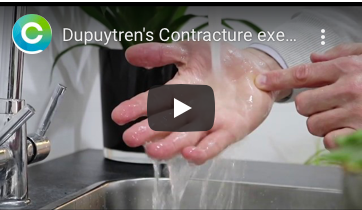 Dupuytren's contracture is a slow growing
inflammatory thickening
on the palm of the hand that eventually creates a deformity of the ring and little finger. It was first
reported in the Lancet in 1831 by the French surgeon Guillaume Dupuytren. Although
medical interventions may be required eventually, we describe
here lifestyle and self help strategies which help relieve the discomfort
especially in the early stages and help delay progression and deformity. Dupuytren's contracture is a slow growing
inflammatory thickening
on the palm of the hand that eventually creates a deformity of the ring and little finger. It was first
reported in the Lancet in 1831 by the French surgeon Guillaume Dupuytren. Although
medical interventions may be required eventually, we describe
here lifestyle and self help strategies which help relieve the discomfort
especially in the early stages and help delay progression and deformity.
Early symptoms; Dupuytren's contracture usually begins as a
fibrous
thickening of the skin on the palm of your hand. As Dupuytren's contracture
progresses, the skin on the palm of your hand may appear puckered or dimpled. A
firm lump of tissue may form on your palm. This lump may be sensitive to the
touch but usually isn't painful.
Later symptoms; In later stages of Dupuytren's
contracture,
cords of tissue form under the skin on your palm and may extend up to your
fingers. As these cords tighten, your fingers may be pulled toward your palm,
sometimes severely. Once this occurs, the fingers affected by Dupuytren's
contracture can't be straightened completely, which can complicate everyday
activities such as placing your hands in your pockets, putting on gloves or
shaking hands. Only rarely are the thumb and index finger affected. Dupuytren's
contracture can occur in both hands, though one hand is usually affected more
severely than the other
Underlying causes;
The deformity is caused by fibrosis and thickening around the tendon sheaths of the
hand which eventual contract. Why these form in the first place is unknown
although it is known to be associated with:
- Age. Dupuytren's contracture occurs most commonly
after the age of 50.
- Cancer treatments; Particularly long term hormone therapies
suc as aroatase inhibitors
- Sex. Men are more likely to develop Dupuytren's and
to have more severe contractures than are women.
- Ancestry. People of Northern European descent are
at higher risk of the disease.
- Family history. Dupuytren's contracture often runs
in families.
- Tobacco Smoking is associated with an increased
risk, perhaps because of microscopic
changes within blood vessels caused by smoking.
- Alcohol High alcohol intake is associated with an increased
risk especially if cirrhosis develops
- Other lifestyle factors: Lack of exercise and high saturated
fat and low low omega 3 intake low antioxidant/polyphenol intake
- Diabetes. People with diabetes are reported to have
an increased risk of Dupuytren's contracture
- Medication; Drug including phenytoin and aromatse
inhibitors
Dupuytren's contracture most commonly affects the ring finger and little, and
occurs most often in older men of Northern European descent. A number of
treatments are available to slow the progression of Dupuytren's contracture and
relieve symptoms
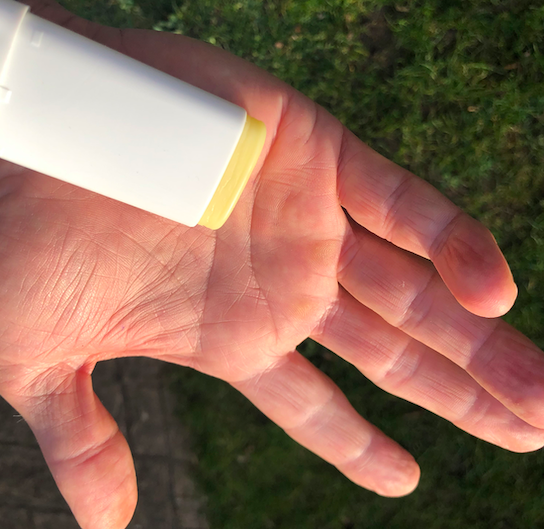 Lifestyle and self help strategies: Lifestyle and self help strategies:
1. Stretch
- Gently bend your fingers backward
from your palm.
- Place your fingers on the edge of a
table, palm down, and then lift the palm upward gradually, as you keep your
fingers flat on the table.
- Rotate the wrist from side to side
- Put your hand in a prayer position pushing the palms and fingers together
- Do not over stretch and cause pain which may be counter productive
- See the film on keep-healthy.com
2. Massage / oils
- Before stretching, warm up your hands in warm water or a heat pad
- Avoid heavily scented creams
- Avoid creams with hydrocarbons and artificial irritation ingredients
- Use a natural plant based moisturiser with natural anti-inflammatory
properties (e.g natureMedical Dupuytrens relief
balm)
- Massage your palms in all directions on and around the thickening
3. Protect your hands:
- Avoid a tight grip on tools by
building up the handles with pipe insulation or cushion tape.
- Use gloves
with heavy padding during heavy grasping tasks.
|
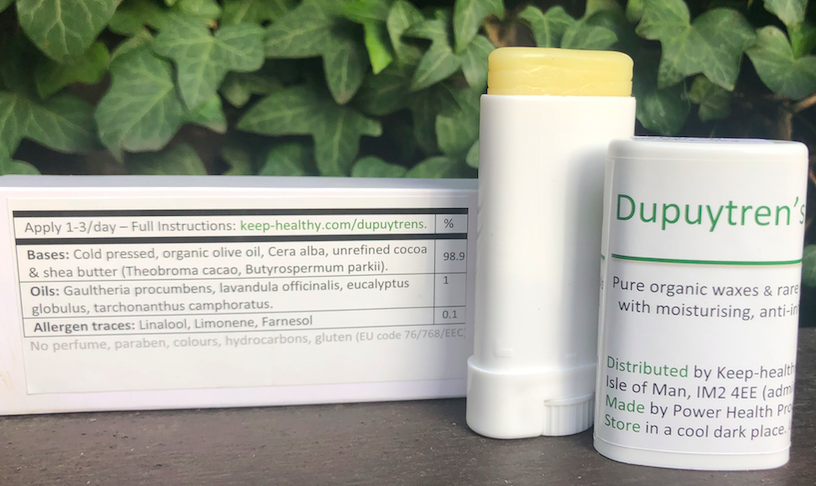
|
- Specifically design for Dupuytren's contracture relief
- Aids massage and stretching
- Completely natural and organic ingredients
- No parabens or hydrocarbons
- No preservatives, colours or scents
- Only rare and pure essential oils
- Naturally anti-inflammatory (wintergreen/African sage)
- Rich in anti-oxidant herbs
- Deep
moisturising properties
|
|
FOR FURTHER INFORMATION ABOUT THIS BALM PLEASE SEE
KEEP-HEALTHY.COM
|
4. Improve your general heath,
particularly:
Medical interventions
If the
disease progresses slowly, causes no pain and has little impact on your ability
to use your hands for everyday tasks, you may not need treatment. Instead, you
may choose to wait and see if Dupuytren's contracture progresses.
Treatment involves removing or breaking apart the cords that are pulling your
fingers in toward your palm. This can be done in several different ways. The
choice of procedure depends on the severity of your symptoms and any other
health problems you may have.
Needling
This technique uses a needle, inserted through your skin, to puncture
and "break" the cord of tissue that's contracting a finger.
Contractures often recur but the procedure can be repeated. Some doctors now use
ultrasound to guide the needle. This might reduce the chance of accidental
injury to nerves or tendons.
The main advantages of the needling technique are that there is no incision,
it can be done on several fingers at the same time, and usually very little
physical therapy is needed afterward. The main disadvantage is that it cannot be
used in some locations in the finger, because it could damage a nerve.
Enzyme injections
The Food and Drug Administration has recently approved injections of an
enzyme, collagenase clostridium histolyticum (Xiaflex) for the treatment of
Dupuytren's contracture. The enzyme in this drug softens and weakens the taut
cord in your palm. The day after the injection, your doctor will manipulate your
hand in an attempt to break the cord and straighten your fingers.
In many ways, this is similar to the needling technique, except that the
manipulation happens the next day, instead of during the injection procedure.
The advantages and disadvantages of the enzyme injection are similar to
needling, except that the enzyme injection may be more painful initially.
Currently, enzyme injections can be used on only one joint at a time and
treatments must be spaced at least a month apart.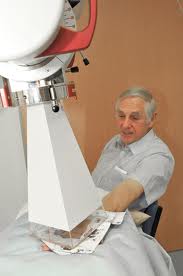
Radiation
therapy
Radiotherapy is a non-surgical treatment that can stop or slow down Dupuytren's
disease in its early stage. In radiation therapy, the nodules and cords
associated with Dupuytren's are irradiated from a distance of .5 - 1 cm either
with X-Rays (e.g. 120 kV = soft X-Rays that do not penetrate deeply into the
body) or with electrons (3 - 10 MeV). This is typically done over five days in a
row ( total dose 15 Gy). After a break of six weeks, this treatment is
repeated.
Surgery
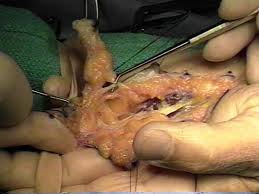 Another option is to surgically remove the tissue in your palm affected
by the disease. This may be challenging because it's difficult to identify
tissue in very early stages of the disease. Diseased tissue may also attach to
the skin, making it difficult to remove and increasing the chances of
recurrence. Another option is to surgically remove the tissue in your palm affected
by the disease. This may be challenging because it's difficult to identify
tissue in very early stages of the disease. Diseased tissue may also attach to
the skin, making it difficult to remove and increasing the chances of
recurrence.
The main advantage to surgery is that it results in a more complete joint
release than that provided by the needle or enzyme methods. The main
disadvantages are that physical therapy is usually needed after surgery, and the
recovery time can be longer.
In some severe cases, surgeons remove all the tissue likely to be affected by
Dupuytren's contracture, including the attached skin. In these cases a skin
graft will be needed to cover the open wound. This surgery is the most invasive
option and has the longest recovery time. People usually require months of
intensive physical therapy afterward.
|

 Lifestyle and self help strategies:
Lifestyle and self help strategies:

 Another option is to surgically remove the tissue in your palm affected
by the disease. This may be challenging because it's difficult to identify
tissue in very early stages of the disease. Diseased tissue may also attach to
the skin, making it difficult to remove and increasing the chances of
recurrence.
Another option is to surgically remove the tissue in your palm affected
by the disease. This may be challenging because it's difficult to identify
tissue in very early stages of the disease. Diseased tissue may also attach to
the skin, making it difficult to remove and increasing the chances of
recurrence.



